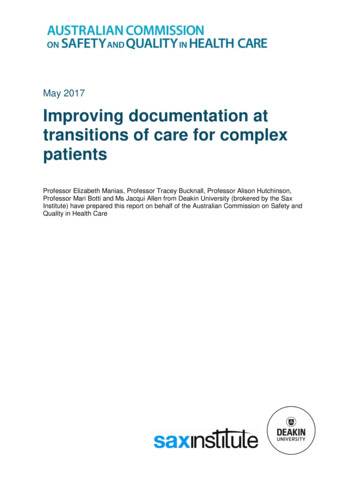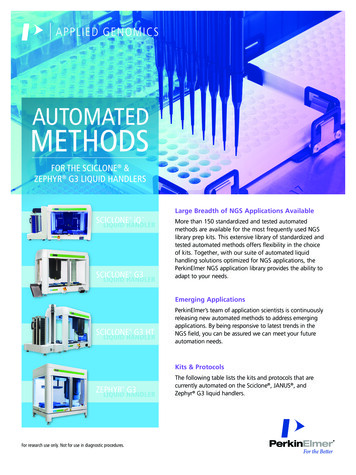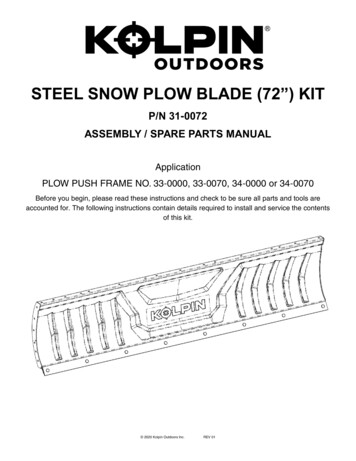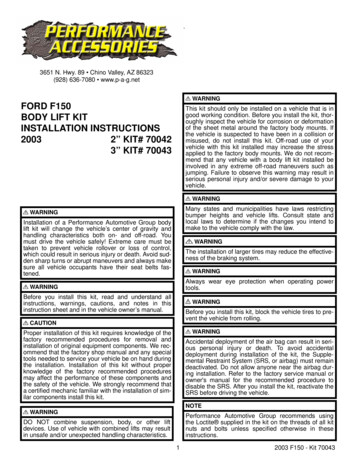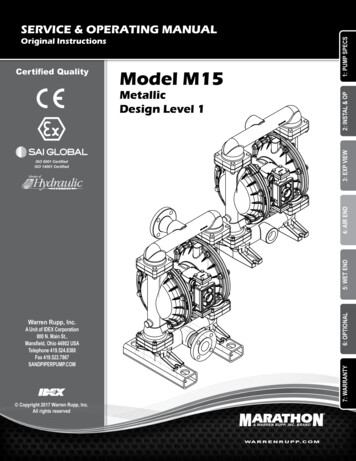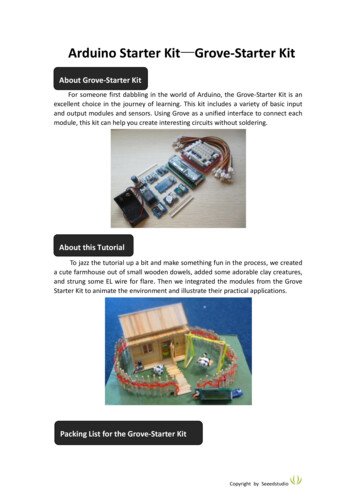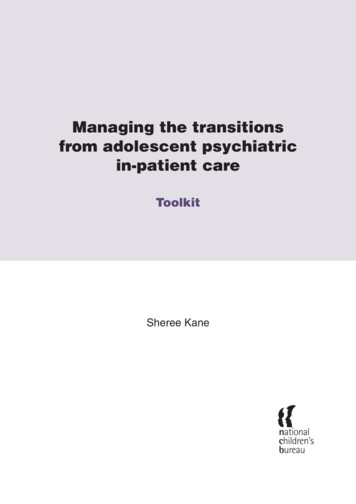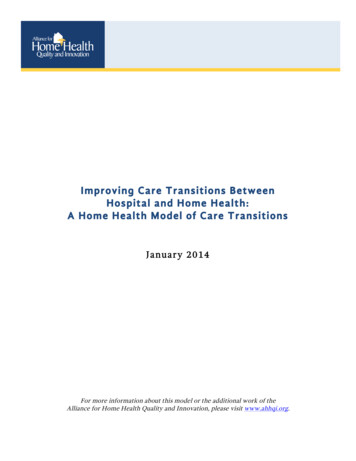
Transcription
Improving Care Transitions BetweenHospital and Home Health:A Home Health Model of Care TransitionsJanuary 2014For more information about this model or the additional work of theAlliance for Home Health Quality and Innovation, please visit www.ahhqi.org.
Docum ent Instructions: These documents are hyperlinked. Please click on any link in theTable of Contents (below) to be taken to that document. Please click the top of any page toreturn to the Table of Contents.Table of Contents !Purpose and Instructions . 4Background and Overview: A Home Health Model of Care Transitions . 5Transitional Care Checklists . 9In-Hospital Transitional Care Checklist . 10Hom e Health Start of Care (First Visit) Checklist . 11Hom e Health Second Visit Checklist . 12Subsequent Visits Per Plan of Care Checklist . 13Key Elements for Care Transitions Tools: Core Components Lists . 14Core Com ponents: Personal H ealth Record (PH R) . 15Core Com ponents: M edication List . 16Core Com ponents: “Red Flags” Sym ptom s Exacerbation Tools . 17Transitional Care Guidance . 18Advance Directives Guidance . 19Universal Health Literacy Guidelines . 20FAQs: Federal Requirem ents and Guidance on Interpretation and Translationfor Lim ited English Proficient (LEP) Individuals . 22Evidence-Based Care Transitions Tools (DO NOT MODIFY) . 24Risk Assessm ent: In-Hospital Assessm ent OASIS-C1 Question M 1033 . 25Risk Assessm ent: In-Hospital IHI Risk Stratification Tool . 26Health Literacy Assessm ent: REALM SF Tool . 27Health Literacy Assessm ent: REALM R Tool . 28Health Literacy Assessm ent: The Newest Vital Sign Test and Scorecard . 34Health Literacy Assessm ent: Single Item Literacy Screener . 36Patient’s Personal Health Assessm ent: EQ5D Tool . 37Patient’s Personal Health Assessm ent: HHCAHPS Tool . 41Hom e Health-Physician Com m unication: Adm ission to Hom e Care Sum m aryfor PCP Tool . 42“Red Flags” Sym ptom Exacerbation: COPD Tool . 43“Red Flags” Sym ptom Exacerbation: Depression Tool . 45“Red Flags” Sym ptom Exacerbation: Falls Prevention Tool . 47“Red Flags” Sym ptom Exacerbation: Heart Failure Tool . 49“Red Flags” Sym ptom Exacerbation: Pneum onia Tool . 51Sample Tool - Personal Health Record (PHR) . 53M y Personal Health Record . 53M y Personal H ealth Goals . 54About Your Personal Health Record . 55M y Personal Inform ation . 56About M y Health . 57Home Health Care Transitions Tool Kit Page 2 of tions
M y H ealth Care Team . 58M y H ealth W ishes (Advance Directives) . 60M y Past Surgeries and H ospital Stays . 62Vital Signs . 63M y Physician Visits . 64How to Give Your Doctor a Quick, Clear Picture of Your HealthProblem Over the Phone . 65Questions for M y Health Care Team . 66Talking with Your Healthcare Provider at the Appointm ent . 68M y M edication List . 69M y Notes . 70Technical Advisory Panel Members . 71Home Health Care Transitions Tool Kit Page 3 of tions
Purpose and InstructionsDeveloped by the Alliance for Home Health Quality and Innovation, this document sets forth ahome health model for care transitions from hospital to home health. This model and itsaccompanying tools are meant to cover the care transition from admission to the acute careinpatient hospital to home health care. In light of the growing emphasis on using appropriatecare transitions and post-acute care to reduce unnecessary hospital readmissions, thedevelopment of this model and accompanying tools has been an initiative to support the homehealth community’s efforts to improve quality of care.The model and tools were developed through an Alliance-convened technical advisory panelcomprised of clinical experts and leaders in home health organizations. These are clinicalleaders who specifically have expertise on providing health care in the home setting. Thetechnical advisory panel members identified the practices and tools set forth in this model ofcare after reviewing the existing literature. Thus, based on their expertise and a review ofexisting literature, the model and accompanying tools represent what key clinical experts inhome health believe are best practices for hospital to home health care transitions that shouldfacilitate improvements in quality of care.The model and tools are intended for use by both home health providers and their hospitalpartners in caring for patients in the context of preparing for, and providing, post-acute care.The Alliance plans to make the model and tools available for public use. Please use these toolsas they apply to your setting and needs. In the future, the Alliance intends to make the modeland tools the basis of testing and evaluating home health’s impact on patient care outcomes. Asevidence is developed over time, the model and tools will be revised as needed.Finally, the model and tools emphasize care for, and communication with, the patient, but wenote that family members and caregivers play critical roles in caring for the patient. Familyand caregiver engagement is often key to ensuring quality of care for the patient and suchengagement should be considered implicit in the model elements and tools.The Alliance wishes to thank the members of the technical advisory panel for theirconsiderable contributions of time, energy and expertise, without which the model and tools inthis document would not exist.Feedback and questions on the model and tools can be directed to the Alliance staff at (202)239-3206.Sincerely,Teresa L. LeeExecutive DirectorAHHQI Home Health Model of Care Transitions Page 4 of tions
Background and Overview:A Home Health Model of Care TransitionsImproving Care Transitions Between Hospital and Home HealthI.Today, health care providers and policymakers are focused on the goals of improving quality ofcare and reducing the overall cost of care. More specifically, many – including the Centers forMedicare and Medicaid Services (CMS)—are focusing on accomplishing the “Triple Aim”: Better care for individuals, as described by the six dimensions of health careperformance listed in the Institute of Medicine’s 2001 report “Crossing the QualityChasm” (safety, effectiveness, patient-centeredness, timeliness, efficiency, and equity);1 Better health for populations, through attacking “the upstream causes of so much of ourill health,” such as poor nutrition, physical inactivity, and substance abuse; and Reducing per-capita costs.In analyzing the opportunities to achieve these goals, many are looking to improve caretransitions, as these hand-offs present particularly important junctures of care for patients.One critical transition is from hospital to home and home health providers are often in the keyposition of helping patients to achieve a smooth and effective transition. Home healthproviders have teams of skilled health professionals who are ready and able to work closelywith hospital staff, patients, and their families and caregivers to facilitate the transition fromhospital to home.Although home health is well positioned to lead and facilitate care transitions, hom e healthis often not sufficiently recognized as being a critical partner in m anaging caretransitions. In part, this stems from the fact that leading edge models to date (such as theNaylor and Coleman models) do not explicitly include home health providers as a member ofthe care team carrying out transitional care interventions. M any hom e health providershave appropriately adapted care transitions m odels to the in-hom e setting in aneffort to im prove care transitions and outcom es for their patients; but there hasnot been a com prehensive effort to identify the steps hom e health providersshould take to im prove the patient care experience and health outcom es duringtransitions from hospital to hom e health care.1See http://www.nap.edu/openbook.php?isbn 0309072808.AHHQI Home Health Model of Care Transitions Page 5 of tions
II.Process: Defining a M odel and Im proving Com petenciesIn light of the key role home health providers are playing every day in care transitions, theAlliance’s Quality and Innovation Work Group (QIWG) discussed the challenges discussed inPart I above and directed Alliance staff to pursue the possibility of a study to define andestablish the effectiveness of a home health model for care transitions. The QIWG also raisedkey issues related to ensuring adequate “competencies” for carrying out effective caretransitions.In defining the role of hom e health in care transitions, the Alliance’s Qualityand Innovation W ork Group recom m ended three key areas for Alliance work:1. Define a hom e health m odel for care transitions;2. Pursue a study to develop evidence on the effectiveness of hom e healthproviders in leading care transitions from inpatient care facilities to thehom e; and3. Im prove the overall hom e health workforce’s ability to m anage patientcare transitions through training which develops the core com petenciesrequired for effective care transitions.The QIWG emphasized the need to ensure that any study of care transitions utilizing homehealth would also require home health professionals that have requisite competencies toexecute a smooth transition. Furthermore, the QIWG encouraged exploration of avenues toenhance competencies in the home health workforce in the U.S. more broadly, such as workingwith the credentialing bodies and professional associations for the various health professionsinvolved in home health.To examine these issues in more detail, the QIWG convened a Technical Advisory Panelcomprised of industry leaders who have focused their careers on improving clinical care,improving quality of care, and building a strong research base for clinical practice.III.The Hom e Health M odel of Care TransitionsThe Technical Advisory Panel began its work with a comprehensive review of existing caretransitions literature across all settings. The panel identified common elements to each modeland selected five core elements that reflected the best practice in transitional care. These fivecore values are the foundation of the transitional care model and include:1.2.3.4.Patient-Centered Focus;Medication Management;Communication and Care Coordination;Timely Follow-Up by the Health Care Team (including the primary care physician andhome health); and5. Patient-activated Education and Coaching.AHHQI Home Health Model of Care Transitions Page 6 of tions
Additionally, the panel identified two global outcomes that it hopes to achieve through thedissemination and practice of the home health model of care transitions: High patient satisfaction, as measured by the HHCAHPS reporting tool; andReduction in 30-day avoidable rehospitalizations following an acute care hospital stay.In order to achieve these outcomes, the model focuses on the 60-day home health episodefollowing the patient’s discharge from the acute care hospital. The model is not intended to becondition-specific, but instead focuses on capturing the clinical best practices necessary toachieve a successful transition from the acute hospital setting to the post-acute care providedin the home.M odel 1: Hom e Health M odel of Care Transitions W ork FlowHome Health Model of Care Transitions Work FlowHospitalAdmissionIn-Hospital Transitional CareAfter the referral to home health, a home health caretransition coordinator (or coach) (“HHCC”) (whoworks for the home health provider) sees the patientwhile still in the hospital.Hospital casemanagement does earlyrisk screening to identifypatients with a high riskof hospital readmission.High orModerateRisk?Hospital casemanagement team (orphysician) and patientdetermine post-acutecare plansHome Health Start of CareFor high risk patients, home health begins within 24hours of discharge. The home health (HH) nurse orphysical therapist (PT) can start care. For moderaterisk patients, the HH nurse or PT begins the Start ofCare within 48 hours of discharge.Referral to SNF,IRF, or home(without homehealth)Referral toHome HealthProviderHome Health Second Visit ChecklistThe HH nurse or PT makes a second visit within 72hours of hospital discharge for patients with a highrisk of hospital readmission. For moderate-riskpatients, the HH nurse or PT should complete thesecond visit or contact (such as a telephone call)within 96 hours of discharge.Subsequent Visits Per Plan of CareIn practice, a home health clinician (a home health nurse, care transition coordinator or coach,or a physical therapist) begins the transitional care at the end of the patient’s care in the acutecare setting. The clinician will work with the patient prior to discharge following the bestpractices outline in the In-Hospital Transitional Care Checklist. For high-risk patients, theAHHQI Home Health Model of Care Transitions Page 7 of tions
clinician will then meet with the patient in-home within 24 hours of discharge2 and completethe Home Health Start of Care Visit Checklist. Within 72 hours of discharge, the clinicianshould meet with the patient again and complete the Home Health Second Visit Checklist.For moderate-risk patients, the clinician should meet with the patient within 48 hours ofhospital discharge3 and complete the Home Health Start of Care Visit Checklist. The clinicianand home health team should then plan a follow up in-person visit or other contact (such astelephone or videoconferencing) within 96 hours of discharge to complete the Home HealthSecond Visit Checklist.For both high-risk and moderate-risk patients, the clinician should continue to reach out to thepatient and complete the Subsequent Visits Checklist as needed over the 60-day episode.In addition to the workflow model provided above, and the checklists included in this packet toaccompany the workflow, the Technical Advisory Panel identified a series of core componentsand example tools to assist clinicians in completing the checklists. These tools and lists of corecomponents for particular tools are included in this document.III.Next StepsLike many innovations, this model of care transitions is in development and will be refinedthrough piloting and practices. The Alliance continues to seek your feedback and suggestionsin refining this model of transitional care.Please feel free to reach out to the Alliance staff at (202) 239-3206 or through the Alliance’swebsite at http://ahhqi.org/contact to provide feedback on this work.2#Medicareprogram regulations require that the home health initial assessment visit “must be held eitherwithin 48 hours of referral, or within 48 hours of the patient's return home, or on the physician-orderedstart of care date.” 42 C.F.R. § 484.55(a)(1). It is the recommendation here that for high risk patients,the initial assessment visit take place within 24 hours of hospital discharge. #3#As stated in footnote 2 supra,#Medicare program regulations require that the home health initialassessment visit “must be held either within 48 hours of referral, or within 48 hours of the patient'sreturn home, or on the physician-ordered start of care date.” 42 C.F.R. § 484.55(a)(1). For moderaterisk patients, it is the recommendation here that the initial assessment visit occur within 48 hours ofhospital discharge. ##AHHQI Home Health Model of Care Transitions Page 8 of tions
Transitional Care ChecklistsAHHQI Home Health Model of Care Transitions Page 9 of tions
In-Hospital Transitional Care ChecklistAfter the referral to home health, a home health care/transition coordinator (or coach)("HHCC") (who is a staff member at the home health provider) sees the patient while thepatient is still in the hospital.The HHCC should complete the following before discharge to home health:Patient Assessm ent! Conduct risk assessment to determine the patient’s risk for rehospitalization (see InHospital Risk Assessm ent tools);! Determine the patient’s language interpretation needs (see FAQS: FederalRequirem ents and Guidance on Interpretation and Translation for Lim itedEnglish Proficient Individuals); and! Perform early medication error risk assessment.Patient Education! Introduce the concept of home health services;! Explain when a home health (HH) nurse or physical therapist (PT) will make the firsthome visit;! Review key information from the hospital chart (e.g., patient demographics, history andphysical exams, history of comorbidities, other hospital services received such astherapy and ongoing needs);! After performing an early medication error risk assessment (below), coach the patientto help them understand their medications prior to hospital discharge (includingunderstanding new or changed prescriptions and emphasizing need to fill thoseprescriptions);! Discuss the patient’s personal goals and explain that HH nurse or PT will follow up inhome;! Make sure patient has home health agency phone number for questions 24/7;! Introduce disease specific red flags (stoplight or zone forms) to the patient and familycaregivers (see exam ple Red Flags tools and Red Flags Tools CoreCom ponents); and! Optional: Work with the patient to conduct a Personal Health Assessment (seesam ple Personal Health Assessm ent tools).Follow-Up Coordination of Health Care Services! Identify the patient’s primary care physician (PCP), especially if hospitalist is used, andcall the PCP regarding signing the patient’s HH orders;! Clarify whether hospital or HH provider will assume responsibility of supporting thepatient’s task to make a follow-up appointment to visit the PCP;! Coordinate with hospital case management on discharge date; and! Communicate with HH office to ensure priority admission for high-risk patients (Startof Care should begin within 24 hours of discharge).AHHQI Home Health Model of Care Transitions Page 10 of tions
Home Health Start of Care (First Visit) ChecklistFor high-risk patients, the home health Start of Care (First Visit) begins within 24 hours ofhospital discharge. For moderate-risk patients, the home health Start of Care (First Visit)should begin within 48 hours of hospital discharge. A home health (HH) nurse or physicaltherapist (PT) can start care.The HH nurse or PT should complete the following at the Start of Care:Patient Assessm ent! Conduct a comprehensive assessment (Note: The OASIS assessment, when required,must be completed within 5 days);! Assess whether barriers to care exist (e.g., environment, supports, transportation, food,drug cost/access), connect the patient with other disciplines (e.g., social work) tofurther assess, and connect with community resources as needed;! Asses the patient’s need for other disciplines (e.g., OT, PT, MSW services); and! Assess the health literacy needs in order to develop HH plan of care, goals andcoaching/teaching needs (see Universal Health Literacy Guidelines guidanceand Health Literacy Tools).Patient Education! Make sure the patient knows how to reach HH agency during and after hours;! Review advanced directives with the patient (see Advance Directives Guidanceand “M y Health W ishes” in the sam ple Personal Health Record)! Briefly discuss personal health record (PHR) and personal goals, but explain that morediscussion will take visit during Visit 2 (see sam ple Personal Health Record andPersonal Health Record Core Com ponents).;! Discuss the plan of care and frequency of visits; and! Introduce red flags for symptom recognition (see Red Flags tools and Red FlagsCore Com ponents).Follow-Up Coordination of H ealth Care Services! Conduct medication reconciliation with close attention to high risk medications andcommunication with the PCP and pharmacist, if possible;! Asks the patient if follow-up appointment with physician(s) have been made (within 7days for high risk patients, and within 14 days for moderate risk patients);! Send the Start of Care report to HH office; and! Send the admission to home care summary to the PCP. Use the SBAR case conferenceworksheet (see Adm ission to Hom e Care Sum m ary for PCP tool) when callingthe patient’s PCP.AHHQI Home Health Model of Care Transitions Page 11 of tions
Home Health Second Visit ChecklistFor high-risk patients, the HH nurse or PT makes a second visit within 72 hours ofhospital discharge. For moderate-risk patients, the clinician and home health teamshould plan a follow-up visit or contact (such as telephone or videoconferencing)within 96 hours of hospital discharge to complete the Home Health Second VisitChecklist.The HH nurse or PT should complete the following during the second visit:Patient Assessment! Continue medication reconciliation.Patient Education! Discuss the patient’s PHR and personal goals with patient in greater depth;! Coach or teach the patient about diet, disease process, and medications usingmaterials that are easy to understand and are appropriate to the health literacyof the patient/family, and using teach back method;! Tie coaching and teaching to the patient’s personal goals to motivate behaviorchange (e.g., smoking, behavior change);! Coach the patient on medication adherence;! Discuss red flags/symptoms in greater depth and when to call the agency,physician (or even 911); and! Coach the patient on how to use modified SBAR when calling the physicianoffice so that critical info is shared with physician and physician's staff (seeAdmission to Home Care Summary for PCP tool).Follow-Up Coordination of Health Care Services! Begin planning for transition to the community, including what communityresources and other services will be needed upon HH discharge;! If physician appointment is not made by Start of Care, HH staff ensure follow-upappointments for the patient have been made;! Discuss telephone calls to be made by HH team between home visits (includingfrequency and preferred time of day); and! Schedule additional HH visits using the same clinicians, when possible.AHHQI Home Health Model of Care Transitions Page 12 of tions
Subsequent Visits Per Plan of Care ChecklistAfter the second home visit, the home health nurse or the physical therapist shouldcomplete the following at each visit:! Promote patient engagement, self-management and support to encourage patientto continue communication with physician after home health discharge(transition to the community);! Keep communication open between patient and PCP to ensure appropriatepatient support;! Ensure patient has access to any needed community and caregiving services;! Conduct ongoing and continual medication reconciliation;! Continue to coach the patient on medication adherence; and! Optional: Conduct a final a Personal Health Assessment (see Personal HealthAssessment tools).AHHQI Home Health Model of Care Transitions Page 13 of tions
Key Elements for Care Transitions Tools:Core Components ListsAHHQI Home Health Model of Care Transitions Page 14 of tions
Core Components: Personal Health Record (PHR)! Large fonts and large section for patient input! Identification of the patient’s personal health goals using clear language (e.g.,“My goal is ”)o Consider posting the patient’s goals in a prominent place in their homeand/or making the goals page a detachable document from the PHR! Advance directives (if any)! Medications List! Allergies! Space for notes from each doctor’s appointment (e.g., list of patients’ questionsand concerns to raise with the doctor;4 change in medications; date of nextappointment)! Grid for patient’s vital signs and tests (including the date, weight, bloodpressure, heart rate, blood sugar, misc.)! Lined page for extra notes! Information on where to get additional PHR booklets4There are separate tools outside of the PHR to help patients prepare to call the doctor and toprepare the patient for the actual doctor’s appointment. Please see the SBAR Tool for CaseConferences within the AHHQI Care Transitions Packet.AHHQI Home Health Model of Care Transitions Page 15 of tions
Core Components: Medication List! Identifies the name of each pharmaceutical drug, over-the-counter medicine, orherbal supplement that the patient is taking;! Identifies prescribing doctor, where applicable;! Identifies what each medicine is used for;! Describes how the patient should take the medicine;! Identifies how much medicine (dosage) the patient should take at particulartimes of the day (Morning Dose, Noon Dose, Evening Dose, Bedtime Dose, AsNeeded Dose)! Includes medication allergies;! Includes pharmacy name(s) and phone number(s);! Optional: Lists medications that the patient does not take anymore, including:o Date Stoppedo Medicine Name and Strength/Dosageo Why the Patient Stopped Taking the Medicineo Prescribing Doctor, if applicable! Optional: Include pictures of the medication and pictures for each time of day tohelp teach the patient how to take their medication.AHHQI Home Health Model of Care Transitions Page 16 of tions
Core Components: “Red Flags” Symptoms ExacerbationTools! Utilizes principles of Universal Health Literacy! Patient name! Color coded zones to indicate that the whether the treatment is working:o “Green Zone” indicating that the patient is managing their disease withoutdifficulty;o “Yellow Zone” indicating that the patient should reach out to a careprovider but is not having an emergency; ando “Red Zone” indicating that the patient should seek emergency treatment.! Phone numbers for the patient’s care team which correspond with each zone:o “Green Zone” and “Yellow Zone”: include the phone numbers for thepatient’s home health provider and primary care physician;o “Red Zone”, include phone numbers for the patient’s home healthprovider, primary care physician and, where appropriate, 9-1-1.o Put phone numbers in a prominent place that corresponds with each zone! Plain language list of patient symptoms and characteristics that indicatemedication and treatment are working in the “Green” Zone! Plain language list of patient symptoms and characteristics that indicate thepatient should seek medical treatment from the home health provider orprimary care physician in the “Yellow” Zone! Plain language list of patient symptoms and characteristics that indicate thepatient should seek immediate, emergency care in the “Red” Zone! Tools available for each major patient diseaseAHHQI Home Health Model of Care Transitions Page 17 of tions
Transitional Care GuidanceAHHQI Home Health Model of Care Transitions Page 18 of tions
Advance Directives GuidanceQuestions for the Patient:1. Do you have a legal document that tells your treating or attendingphysician who can make health care decisions for you if you cannot makethem yourself? This document is often called a “durable power ofattorney”, a “medical power of attorney”, or a “healthcare surrogate.” IfYes, please provide a cop
and selected five core elements that reflected the best practice in transitional care. These five core values are the foundation of the transitional care model and include: 1. Patient-Centered Focus; 2. Medication Management; 3. Communication and Care Coordination; 4.



